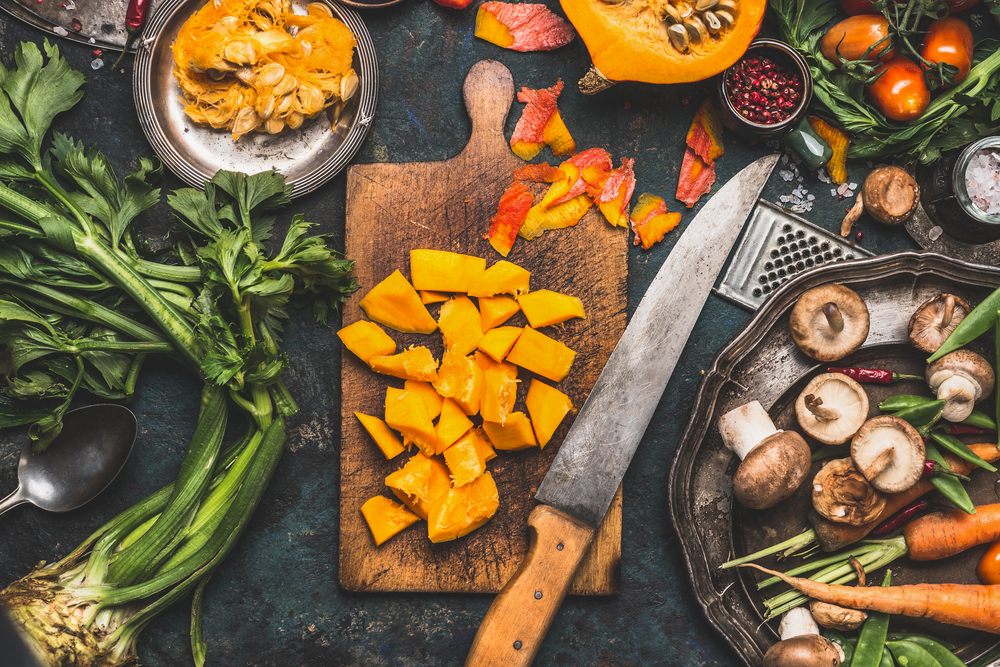The changing of seasons gives way to seasonal food that we look forward to all year, but the most anticipated and celebrated are by far the flavors of fall. While pumpkin spice gets all the glory for sweet autumn items, there’s a lot of delicious iconic fall flavors and menu options that only come up this time of year as savory dishes, too. For 2020, the emerging trends for these limited-edition offerings include many favorites from years past and some new tastes entering the mainstream in surprising ways.
Hungry for more? CLICK HERE to subscribe to our weekly newsletter!
Mainstay Faves
You can’t introduce a fall menu without some much-anticipated staples, the main one being the star of the season: pumpkin. Pumpkin continues to be one of the most popular flavors even outside of sweet desserts, with pumpkin increasingly being added to vegetable dishes, bowls, soups, and curries. Pumpkin seed oil is also being added to beverages, alcoholic and non-alcoholic, and marketed for its natural benefits. Nellie Rae’s Kitchen in Bucks County, PA offers pumpkin soup with a coconut milk base and raw pumpkin tort with almond crust, highlighting the health and functional qualities of the versatile squash.
 Speaking of, squash is finding more momentum as new varieties, like red kuri and pattypan, take on the classic butternut which has become ubiquitous as the squash of fall, with squash added to mixed vegetable sides and atop pizzas. Over the last two years, there has been a 300% increase of squash as the choice of protein for Asian bowls, according to the Technomic Season’s Eatings report for Fall 2020. In NYC, Junzi Kitchen offers a barbeque squash as a side or main protein while Roast Kitchen includes kabocha squash in their Thai red curry. At Hex Coffee in Charlotte, NC has featured a kobocha squash latte with cinnamon, star anise, cardamom and brown sugar.
Speaking of, squash is finding more momentum as new varieties, like red kuri and pattypan, take on the classic butternut which has become ubiquitous as the squash of fall, with squash added to mixed vegetable sides and atop pizzas. Over the last two years, there has been a 300% increase of squash as the choice of protein for Asian bowls, according to the Technomic Season’s Eatings report for Fall 2020. In NYC, Junzi Kitchen offers a barbeque squash as a side or main protein while Roast Kitchen includes kabocha squash in their Thai red curry. At Hex Coffee in Charlotte, NC has featured a kobocha squash latte with cinnamon, star anise, cardamom and brown sugar.
Moving from the light, refreshing flavors of summer into the more comforting, heartier flavors of fall is highlighted in foods like brussel sprouts and cauliflower. While still most popular as a roasted side dish to chicken and beef, gaining popularity are new hybrids of greens like the “lollipop kale” brussels sprout-kale hybrid, often found fried and crispy as an appetizer or found in healthy specialty salads. Cauliflower has become an alternate staple as an additive to pizza crust or as a mashed potato substitute, but cauliflower, especially orange and purple varieties, also holds its own as it increases in popularity in veggie bowls and curries. At Little India in Denver, cauliflower is the main ingredient in their Gobi Masala; its mild taste highlights the cream and spices it is cooked in.
RELATED: 8 Fall Ingredients That Aren't Pumpkin Spice
A Sweet Twist on Savory
Two iconic autumn ingredients in sweet dishes are making the move in interesting ways to savory. Pecans are not hard to find sprinkled on donuts and baked into pies or candied and added to a specialty salad, but increasingly, pecans are added to cheese and cheese platter appetizers and vegetable sautés, increasing 80% in popularity over the last two years, pairing perfectly with comforting root vegetables as side dishes. It also shines in stuffing during Thanksgiving or substituting super-sweet marshmallows for a savory, nutty flavor as a baked yam topping.
Apple picking is a top fall activity, but orchard visitors should set aside a few apples for savory condiments after baking their classic apple pie. According to Technomic, there has been a 175% increase of apples added to condiments in two years, pairing sweet with savory to make the perfect topping for hearty meats like apple and caramelized onion chutney or pickled apples for a sweet-acidic flavor combo that works perfectly as a slaw.
Emerging Flavors
 While sweet potatoes are a staple for Thanksgiving meals, white sweet potatoes are gaining popularity on menus as a perfect balance, with the texture of a white potato and a slightly sweet taste borrowed from the orange sweet potato. Most sweet potatoes are generally available year around with the peak season falling from late October through December. Marisol in Chicago offers a seared scallops dish with sunchoke, white sweet potato, and buttermilk dashi, while Mariel in Boston serves Avocado Con Mojo, featuring crushed avocado, rustic mojo, and white sweet potato chips.
While sweet potatoes are a staple for Thanksgiving meals, white sweet potatoes are gaining popularity on menus as a perfect balance, with the texture of a white potato and a slightly sweet taste borrowed from the orange sweet potato. Most sweet potatoes are generally available year around with the peak season falling from late October through December. Marisol in Chicago offers a seared scallops dish with sunchoke, white sweet potato, and buttermilk dashi, while Mariel in Boston serves Avocado Con Mojo, featuring crushed avocado, rustic mojo, and white sweet potato chips.
Floral flavors are not common in fall; however chrysanthemums are starting to emerge on menus, especially in Asian cuisine, as an edible flower with a versatile flavor that shifts from sweet to tangy to bitter to peppery depending on the varietal. Blooming in late summer into early winter, chrysanthemums have a peak season in late September through October with edible buds and greens, making them the perfect addition to a fall food plate. Ramen Gaijin in Sebastopol, California offers Omugi Take Nabe, with purple barley porridge, egg yolk, porcini, shiitake, maitake, katsuobushi and chrysanthemum, while Don Angie in NYC offers a salad with chrysanthemum greens in olive oil and lemon juice and finished with Caesar-style toppings.
Seasonality is about novelty, flavor, functional benefit, association, excitement and priming. It also reflects our vision of the world—weather, time of year, ingredients, locales, cultures, etc. With the right balance of market curation and experimentation, seasonality is a powerful product development tool. At the same time, it can be expensive and hard to pull off without a healthy balance of change and stability.
Symrise’s Seasonality Initiative offers a framework to help our customers develop pipelines of new concepts and flavor ideas for the seasons and major holidays. If you have questions or would like to learn more about our initiative please contact us.






